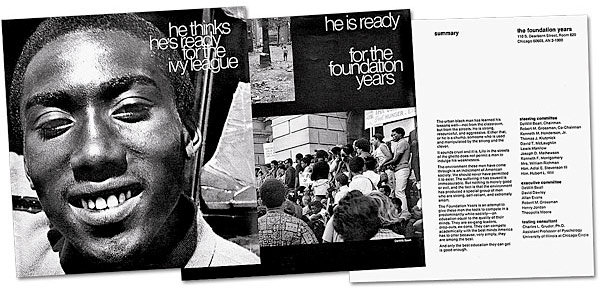
Pages from the Foundation Years 1968 promotional catalog, from "Students from the Street"
Earlier this fall Chicago featured a series of posts on our Off the Grid blog by Alex Kotlowitz, focusing in part on The Interrupters, his recent documentary with Steve James. As you're likely aware by now, it's about CeaseFire, which is not just an attempt to stop the transmission of violence from one instance to the next, but also to employ Chicago gang members, transitioning them out of the life by adapting their knowledge and experience to the broader goals of the community.
It's a fascinating story, and not the first in the city's long history of gang violence. Here are three excellent reads, two from Chicago, about past attempts to move gang members into the community during the culturally combustive years of the late 1960s.
* "The Making of Jeff Fort," Chicago, November 1988, by Tom Brune and James Ylisela, Jr. A long, detailed history of the man who's probably still Chicago's most notorious gang leader after Al Capone:
At age 41, Jeff Fort is the nightmare of the 1960s that just won't go away. He made his reputation in that tumultuous decade as one of the leaders of the Blackstone Rangers street gang and its successor, the Black P Stone Nation. Hated and harassed by the police, admired and feared by thousands of poor black kids, embraced and funded by well-intentioned idealists trying to end gang violence and attack poverty and racism, he played a role in the lives of some of the biggest names in town: Richard J. Daley and his son, Charles Percy, Jim Thompson, James Montgomery, Jane Byrne, and Jesse Jackson, to name a few."
Fort remains in prison, "the first man in the United States to be convicted of terrorism," for trying to cut a deal with recently-executed Libyan leader Muammar Gaddafi in which his El Rukns would serve as terrorist hitmen: $2.5 million to commit terrorism against the U.S.
* "Art & Soul: An Experimental Friendship between the Street and a Museum," Arts Journal, Summer 2001, by Rebecca Zorach. Around the time Fort's Blackstone Rangers were working with The Woodlawn Organization on a federally-funded, gang-run job-training program, the Museum of Contemporary Art partnered with CVL, Inc.: "CVL" being short for Conservative Vice Lords.
Art & Soul was not entirely outside the mainstream art world. It was a point of intersection: between the new aspirations of late 1960s museums and forms of creativity born of the desperate conditions of an African American ghetto; between the young Black Arts Movement and older, established African American artists. At base it may have been just a fresh episode in the history of the periphery of mainstream art institutions. But it was a moment of optimism, coalition, and risk-taking that may have lessons for the future.
* "Students from the Street: A Look at Dartmouth's Foundation Years Project," Chicago, August 2011, by Jay Pridmore. In case you missed it, a great recent article on a 1967 Dartmouth program—the same year Fort began working with TWO and a year before Art & Soul was set up—which recruited young North Lawndale Vice Lords to attend the college.
Fifteen men were admitted. Seven graduated with bachelor’s degrees; eight dropped out. Almost all of them returned to Chicago, most to the city’s segregated neighborhoods, where half beat the odds and found productive careers. The other half did not, and six of them died in the inner city’s clutch of drugs and guns, a plague that was becoming lethal just as these men were going east to school.


